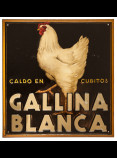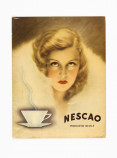Food

Gallina Blanca. Caldo en cubitos. Poster. Tin. c. 1940. Indústria Metalgráfica, S.A., Barcelona. Col. Mateu Llinàs i Audet. Photo: Frederic Camallonga

Nescao. Producto Nestlé. Cardboard. c. 1930. Rieusset Cía. Gral de Industrias Gráficas, Barcelona. Col. Mateu Llinàs i Audet. Photo: Frederic Camallonga

Chantecler. Barquillos Chantilly. Tin. c. 1915. G. de Andreis, Badalona. Col. Mateu Llinàs i Audet. Photo: Frederic Camallonga
The proliferation of products from new industries made it possible to standardise manufacturing, conservation and distribution systems. This reduced costs and sales prices, which meant they became accessible not only to the bourgeoisie but also to the lower classes. This change was notable in the food sector, which due to changes in lifestyle brought about by the industrial world, offered a series of products that simplified making meals, such as concentrated soups, powdered or condensed milk, as well as biscuits, chocolate and coffee, which then became available in packages with a guarantee of conservation and hygiene. But their qualities had to be made known to the general public, as until then, these products were home-made and sold in bulk, like oil. Customs were changing and producers had to attract possible buyers. Although the first commercial posters were artistic, i.e. the concept and the image were closer to art than to advertising strategy, the aim was to divulge the qualities and benefits of the products, with special emphasis on the name of the manufacturer. The message became progressively “professionalised” and slogans for products appeared, in order to get customers’ attention: milk “makes you strong and healthy” or it is “the best nourishment for kids”; biscuits “are the choicest”; and cocoa “the ideal food”. In the end the image and the text formed a whole.



